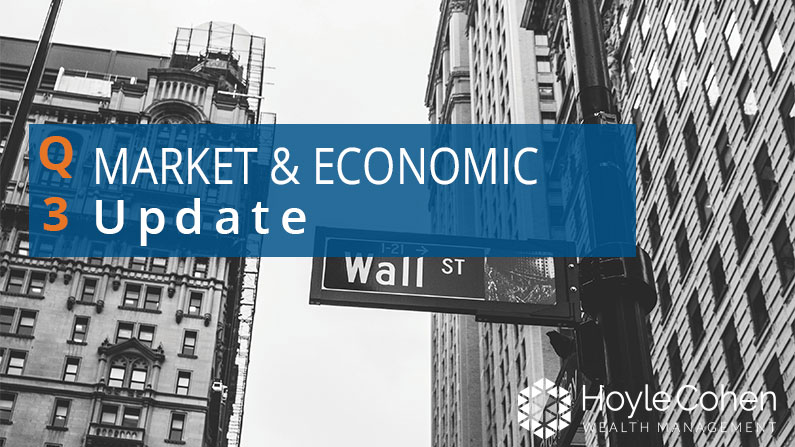Market & Economic Update – October 2020
By: HoyleCohen Investment Committee Members: Peter Mueller, Vanessa Wieliczko, & Steve Taddie
It’s a common refrain in the investment world which holds especially true today – the stock market is not the economy. The rally in U.S. stock prices off of the March 23rd market low continued during the 3rd Quarter as global economic activity, corporate profits, and consumer sentiment all continued to improve. The stock market, as measured by the Standard & Poor’s 500 stock index, rallied 8.5% during the quarter inclusive of a 10% correction in September. We believe the correction was a short-term pause that weeds out some market excess resulting from the sharp share price rise in August, angst about volatility surrounding the election, and the on-again off-again hopes for a follow-on stimulus to the CARES Act passed in March. As of this writing, the politics surrounding the passage of a new stimulus package seems a bit like a Peanuts cartoon with Lucy pulling the football away from an eager Charlie Brown.
On the positive side, the long-term catalysts for market support remain in place – massive monetary stimulus by the Federal Reserve, eventual passing of fiscal stimulus by Congress, and a gradual adaptation to life and business in today’s pandemic era. The Federal Reserve continues its whatever-it-takes approach to support markets and economic activity by keeping interest rates at 0% and providing excess liquidity through asset purchases (it now holds over $7.5 trillion of assets on its balance sheet). At present, it is telegraphing near 0% interest rates for the next few years and is doing its best to push inflation expectations higher – citing its target for inflation at an average of 2% over longer periods of time. This means the accommodative monetary policy should persist, even if inflation runs well beyond 2% for a number of years which will continue to provide support to asset prices.
While economic conditions continue to improve, many businesses (especially small business) and workers have been severely impacted by the pandemic induced recession. On the micro level, we have experienced a “K” shaped economic recovery as asset light and tech-centric industries are performing well, while many small businesses that are epicenter to the crisis (i.e. travel, leisure, dining, personal services, etc.) have suffered severely. Similarly, employment in many professional or white collar industries have remained steady, while workers in the part-time economy and in companies that are epicenter to the crisis have suffered greatly. The pain experienced by many businesses and workers epicenter to the crisis underscores the continued need for government support (fiscal spending) enacted by Congress. The risk of going too big on fiscal stimulus is much smaller than the potential damage caused by no action or a stimulus package that is too small. According to David Rosenberg (Chief Economist and Strategist at Rosenberg Research), “… this is not a time, given the size of the output gap, to be doing anything less than something big fiscally. If it proves too big, so what? Dealing with an overheated economy is a lot easier than what we’re dealing with now.”
Outside of small business and those businesses epicenter to the crisis, US corporations are in good shape. Well-capitalized and run corporations can be quite nimble during economic downturns as expected revenue short-falls can be offset, to some extent, by adjusting variable expenses such as labor and marketing, and/or postponing capital investments. This is not sleight of hand. It is what strong businesses do to make it through more difficult times. The transition phase, back to a more traditional environment, is happening and the competitive landscape is changing. Some companies have increased market share within their industry, while others have lost it. For those in the most effected industries, that difference could be the key to survival. These are the times where exceptional management and a healthy balance sheet can make a big difference.
Americans are fortunate that the U.S. government has access to huge amounts of capital, U.S. corporations have very healthy balance sheets, and consumers were in pretty good shape financially prior to the virus induced downturn. The longer it takes to get to the other side of the fight against the virus, the more embedded changes in consumer and business habits will become. That said, future success may be more a function of understanding and managing one’s response to the changes rather than assuming things will return to the old normal.
Despite the challenges and continued need for political action today, we are optimistic for the future of U.S. business and the battle tested American worker and consumer. The massive monetary and fiscal bridges built by our government will get us to the other side of covid and the covid-induced recession. 2020 has set a low bar for a better year in 2021 as the benefits of scientific breakthroughs impact our future and future policy choices. We will continue to be patient and persistent stewards of your capital by maintaining a broad perspective while focusing on investing in high quality assets.
We appreciate your continued confidence and support, and as always, please contact your advisory team if you have any questions or wish to discuss.
Sincerely,
Your HoyleCohen Team

